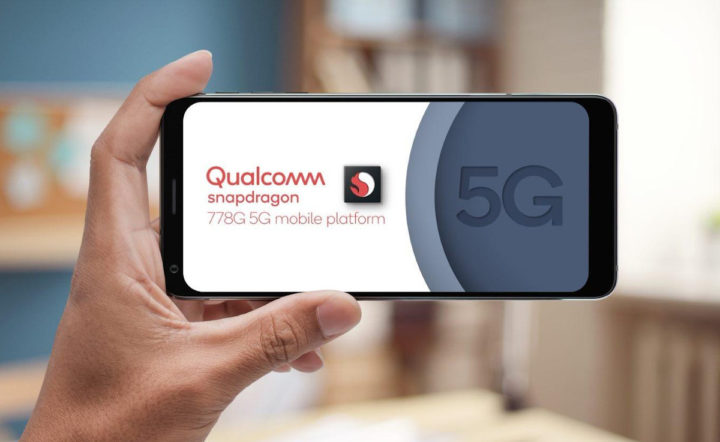There used to be “premium mid-range” smartphones, but Qualcomm now calls those “high-tier” smartphones in the recent announcement of Snapdragon 778G 5G processor succeeding Snapdragon 765G/768G 5G mobile platforms.
The octa-core Cortex-A78/A55 SoC features a Snapdragon X53 5G Modem supporting up to 3.7 Gbps downlink, support FHD+ display up to 144 Hz, up to 16GB LP-DDR5 memory, and packs 12 TOPS of AI processing power.
Snapdragon 778G (SM7325) specifications:
- CPU – Eight Kryo 670 CPU cores including 4x Arm Cortex-A78 @ 2.4GHz and 4x Arm Cortex-A55 @ 1.8GHz
- GPU – Adreno 642L with Vulkan 1.1, Snapdragon Elite Gaming features, H.265 and VP9 video decode, HDR10+, HDR10, HLG
- DSP – Hexagon 770 Processor with fused AI Accelerator architecture, Hexagon Tensor Accelerator, Hexagon Vector eXtensions, Hexagon Scalar Accelerator
- 2nd generation Qualcomm Sensing Hub
- Memory – Up to 16 GB LP-DDR5 memory up to 3200 MHz
- Display
- On-Device Display – up to FHD+ @ 144 Hz
- External Display – up to 4K UHD @ 60 Hz with 10-bit color depth, Rec. 2020 color gamut, HDR10, and HDR10+ support
- Camera
- Qualcomm Spectra 570L Image Signal Processor
- Triple 14-bit ISPs
- Up to 22 MP triple camera @ 30 FPS with Zero Shutter Lag
- Up to 36+22 MP dual camera @ 30 FPS with Zero Shutter Lag
- Up to 64 MP single camera @ 30 FPS with Zero Shutter Lag
- Slow-mo video capture at 720p @ 480 FPS
- HDR – HDR10+, HDR10, HLG
- HEIF: HEIC photo capture, HEVC video capture
- Audio
- Hexagon Voice Assistant Accelerator for hardware-accelerated voice signal processing
- Qualcomm Aqstic audio codec up to WCD9385
- Qualcomm Aqstic smart speaker amplifier up to WSA8815
- Connectivity
- 5G Modem-RF System
- Snapdragon X53 5G Modem-RF System
- Multimode support: 5G NR, LTE including CBRS, WCDMA, HSPA, TD-SCDMA, CDMA 1x, EV-DO, GSM/EDGE
- 5G mmWave and sub-6 GHz, standalone (SA) and non-standalone (NSA) modes, FDD, TDD
- 5G mmWave: 400 MHz bandwidth, 2×2 MIMO
- 5G Sub-6 GHz: 100 MHz bandwidth, 4×4 MIMO
- Downlink: Up to 3.7 Gbps
- Global 5G multi-SIM
- Wi-Fi & Bluetooth
- Qualcomm FastConnect 6700 Subsystem supporting WiFi 6E, WiFI 6 (802.11ax), WiFI 5 802.11ac Wave 2, 802.11a/b/g, 802.11n up to 2.9 Gbps
- Bluetooth 5.2 with Qualcomm TrueWireless Technology, aptX Adaptive, Bluetooth LE audio (one to many broadcast)
- Location – GPS, Glonass, BeiDou, Galileo, QZSS, NAVic capable
- Near Field Communications (NFC)
- 5G Modem-RF System
- USB – USB 3.1 Type-C with support for DisplayPort alt-mode
- Security
- Platform Security Foundations, Trusted Execution Environment & Service
- Qualcomm wireless edge services (WES) and premium security features
- Qualcomm 3D Sonic Sensor and Qualcomm 3D Sonic Max (fingerprint sensor)
- Qualcomm Type-1 Hypervisor
- Charging – Quick Charge 4+ technology
- Manufacturing – 6 nm Process Technology
Qualcomm claims a 40% performance boost both for the CPU and GPU over Snapdragon 768G. But as noted by XDA developers, Snapdragon 778G is quite similar to the Snapdragon 780G announced a couple of months ago but with all Cortex-A78 cores clocked at 2.4 GHz instead of 1x @ 2.4 GHz + 3 @ 2.2 GHz, and 5G downlink peaks at 3.7 Gbps instead of just 3.3 Gbps, plus 5G mmWave is supported, and LPDDR5 memory is supported instead of just LPDDR4.
Snapdragon 778G powered 5G phones are expected in Q2 2021, which should mean next month, from companies such as HONOR,iQOO, Motorola. OPPO, realme, and Xiaomi. More information may be found on the product page.

Jean-Luc started CNX Software in 2010 as a part-time endeavor, before quitting his job as a software engineering manager, and starting to write daily news, and reviews full time later in 2011.
Support CNX Software! Donate via cryptocurrencies, become a Patron on Patreon, or purchase goods on Amazon or Aliexpress





